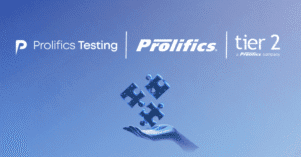Table of Contents
-
- How MACH Started
- What is MACH Architecture?
- How MACH Structures Streamline Your Services
- Microservices
- API-First
- Cloud-Native
- Headless Architecture
- The Benefits of MACH Architecture
- MACH Architecture vs Traditional Frameworks
- Expert Insight From Prolifics UK Head of Technology, Marc Edwards
- Getting Started with MACH
- Need Help? Consult MACH Architecture Experts
As we barrel headlong into the so-called Fourth Industrial Revolution, many businesses are turning to a new architecture that can withstand the growing digital needs of customers. This microservices-based, API-first, cloud-native, and headless (MACH) architecture simplifies the deployment of technology throughout your organisation, creating a powerfully reusable framework to innovate and respond to demand.
MACH is built around open technology, aiming to enhance enterprise software. It represents the efforts of a global community that aims to make business more adaptable. Certain technology firms—such as Prolifics—are experts in implementing MACH architectures and assisting clients in making the migration to a MACH-enabled digital technology stack.
This is a fundamental rethink in how organisations produce software. Instead of fixed “monolithic” work that becomes stale, MACH code becomes a highly responsive organism. Many small elements work together to respond fast to the evolving needs of the market.
MACH is built for the future. While it does take some time and effort to migrate monolithic systems to this new approach, the payoff comes with faster innovation. It’s an investment that’s well worth making—this is the next generation of technology.
How Did We Get Here?
MACH first took off—and remains popular now—in response to the fact that certain industries couldn’t keep up with customer expectations. eCommerce vendors struggled to keep pace with rapidly shifting digital trends, and needed a solution.
Some of the problems with legacy approaches included slow web pages, brittle platforms, high costs to build or modify, and technical limitations. Also, tech workers want to work with tomorrow’s tools, not yesterday’s—so monolithic projects had a hard time finding quality developers.
In response, they developed a brand new IT methodology. Instead of one-size-fits-all (or realistically, one-size-fits-none), the industry turned to a modular approach. This more limber framework makes sudden adjustments—whether to upgrade the user experience, for legal reasons or to make operational changes—more feasible.
The end result is MACH, in which you can compose an enterprise solution from modular building blocks. High-profile organisations are already reaping the rewards, with notable examples including Amazon and Uber. Will you be next?
What Is Mach Architecture?
MACH architecture is an approach to enterprise software that builds from the four ideas in its initials:
- Microservices
- API-first
- Cloud-native
- Headless
It has a modular design to allow organisations to assemble solutions from small high-quality elements.
In this way, MACH architecture contrasts with earlier approaches, which attempted to build each solution as a standalone application. That legacy approach often resulted in difficult-to-maintain products. The more modern MACH structure frees you to mix and match rapidly, adapting to the dynamic business environment.
All components are built around cloud technology, increasing capability dramatically. The four elements of MACH have been always been available separately—this new structure combines them synergistically into a cohesive architecture.
Much of the uptake for MACH came about in response to Covid-19. Suddenly businesses had to adapt to a rush to online channels and remote workers, needing a seamless solution that powers through regardless of where customers and workers are. The new paradigm became urgent for survival.
This broad-based move to the cloud has also driven the explosion of the API economy. Companies of all sizes have taken advantage of app connections to speed up and even build businesses. Prolifics has supported a number of clients in joining the API economy to increase innovation.
MACH Structures Streamline Your Services
MACH simplifies the process of delivering experiences across different devices. With these reusable modules, you can just plug the same business logic into different presentations. It’s also easy to build apps of various sizes since you can combine as many microservices as necessary.
Tool Availability
A MACH architecture also lets you use the best available tools. You’re free to leverage the strong suits of several different apps since you’re not locked into a monolithic design. And if a better tool comes along later, you can make the substitution painlessly.
To ground the idea a bit more, let’s say you’re building an eCommerce site. To do so traditionally, you’d build a single app with the content and front end. But doing so the MACH way, you’d plug in different interfaces—like web, mobile, or even in-store—and a range of APIs streamline the process of adding payment methods, recommendation tools, customer relationship data, or any other functionality you please.
Upgrades
MACH makes it easier to upgrade your site; you can modify any microservice without worrying over disruptions to the rest of the service. This is a major relief since managers often put off upgrades to monolithic designs for fear of interfering with the rest of the site’s functionality.
Composability
The ideas behind MACH can be summarised with the word “composability.” This refers to building (or “composing”) solutions out of smaller independent elements. As a result, you shape the IT ecosystem to match your business needs. This runs opposite to monoliths that lock you into a certain way of doing things, such that you have to adapt your business needs to the software.
The Four Elements of MACH
The MACH architecture enables a composable enterprise where you can take each component and modify it however you want: edit, remove, or reconnect. Let’s examine each of the four elements of MACH to draw out the nuances even more.
Microservices
Microservices are pieces of functionality that work together to deliver complete apps. Each microservice does one thing and does it well. A product team overseeing a specific microservice develops and maintains that functionality.
A microservice can have its own database and execution environment. It’s a small programme of its own, essentially. The different microservices use a process called service discovery to find how to communicate with each other.
The rationale for using microservices is that it’s more efficient. You’re breaking down complex problems into useful pieces, then solving each piece in the best way possible.
Consider each microservice building block as an expert at its task, compared to having one monolithic codebase accomplish all goals—perhaps not exceptionally well. Since you can combine microservices, it’s then fast and easy to compose solutions to unforeseen problems that arise.
Some commonplace examples of microservices include product reviews, pricing, payments, and promotions. Architecturally, microservices have containers that ensure each unit is consistent and tested. Each service has its own IP address and public interface.
Microservices operate independently, communicating with each other through APIs. If a microservice malfunctions, the system is designed so that the rest of the application does not go down.
API-First
An application programming interface (API) is essentially an automatic connection between two systems. A common metaphor for an API is a waiter who carries messages with instructions from patrons to the kitchen. While APIs themselves have been in use for some time, the notion of building “API-first” is a more recent development. One designs with the API connections in mind, thus simplifying all further development.
When you start with the API, you have a clear reference of how any component should behave. This makes it straightforward to add, edit, or fix code as you go. This also provides a well-documented method to connect different components together, enabling the composability of microservices.
A Note From Your Prolifics Pros:
Prolifics specialises in API-first design. Bridging together internal and external systems, APIs are key to integrating multiple tools and data repositories. APIs are the glue that allow your old and new services to work together effortlessly, adapting in response to changing circumstances. As a leading digital engineering consultancy, we know how to bring your data into the API-first era.
APIs send and receive instructions—only the most essential data that needs conveying. Within the microservices, these instructions then convert into the desired outcome. You interact through the APIs, without having to know the details of how each microservice runs its calculations. This simplifies the process of using multiple different modules.
For example, you might connect an eCommerce site to various payment processors through APIs. When a customer shops on your site, messages including the cost and account number transfer to the processor service. They execute the payment—then your eCommerce solution continues the process, showing the customer a receipt.
Remember that not all APIs are created equal. There’s a certain degree of technical skill involved in producing a useful API; as such, while an API-first ideal remains generally valuable, it’s also important to have high-quality APIs. Be sure to consult an API expert to evaluate the design of any interfaces under consideration.
Cloud-Native
Many companies were understandably wary of early cloud software functionalities. But now, this technology has become mature, and an increasing number of applications deliver by default from the cloud, or “as-a-service”.
Going cloud-native in this way expands your available resources dramatically. You have access to far more compute, storage, and network connectivity. Cloud apps are faster and more flexible, and nowadays people have come to expect their efficiency.
A cloud-native approach brings several additional benefits. You don’t need to install and maintain systems by hand. Automatic upgrades and multilayer security also make these apps more reliable and provide fast and resilient access for users anywhere on the planet.
When Covid-19 struck, every industry had to adapt its work models. The cloud came to the rescue by allowing people to perform their functions from anywhere. This has taken some adjustment for IT teams—and many companies didn’t respond well. Nonetheless, the companies that went cloud-first readied themselves for what has become a standard and efficient method of working.
A Note From Your Prolifics Pros:
Prolifics offers a range of cloud services to help organisations thrive. Whether you want to start a new project or move your existing logic into the cloud, we can accelerate your trajectory. From planning through tool selection and deployment, we’re with you every step of the way to ensure a safe and effective transition. We’re expanding our cloud-native offerings with the acquisition of Tier 2 Consulting, an established Red Hat partner here in the UK. This development will grow the size and number of solutions we deliver even more. Open source code built specifically for the cloud is enabling a new generation of apps.
Headless
A headless architecture separates the so-called front- and backends of a software solution. The front end refers to the user interface, while the back end refers to the underlying business logic. This separation lets you freely reuse the business logic backend, increasing your agility in several notable ways.
- Customisable user experiences. You’re no longer tied to a specific front end, as in the case of traditional monolithic designs. Now you can have different front ends for each channel, connecting to backend microservices through APIs.
- The choice of programming languages and tools. There’s no commitment to a specific path. You can even use different frameworks for different front ends.
- Exploration of new business models. Test out different front ends, such as voice or social commerce—just plug any of these new front ends into your existing backend microservices.
Since the backend processes will look basically the same regardless of where you sell, it makes sense to decouple the front end. Instead of having to design multiple applications for each customer touchpoint, you just connect the different front ends to your headless back end.
The flexibility of this approach makes it useful well beyond the phone and laptop. You can also hook up to vending machines, IoT devices, chatbots, marketplaces like Amazon, or your own shops and warehouses. It makes omnichannel fulfilment practical.
How Can MACH Architecture Benefit You?
The MACH architecture future-proofs your development efforts. With legacy app development, your application starts to become outdated from the moment you write it. By contrast, MACH simplifies reuse. Quickly adapt your app to whichever new situations arise.
A Note From Your Prolifics Pros:
If you’re unsure of how to reap the benefits of MACH—or want more assurance that you’ll see the rewards—learn what Prolifics can do for you with Red Hat OpenShift.
The Covid-induced digital shift is giving MACH a further boost. More organisations are switching from large legacy systems to smaller and more manageable apps. They’re reusing mini-services, separating off front ends to go headless. APIs then bring the whole ecosystem together.
This is bigger than just a different software development model. It’s a culture shift. Organisations are moving from silos to reusable modules that work across departments and business partners. Suddenly it becomes much faster to bring out new features, with input from experts in all departments.
The agility you gain will help you stay ahead of the competition. While they’re busy redeveloping an app for a new platform, you’ve already incorporated all your modular components into a new app. MACH makes it simple.
You can add functionality to your apps on any platform with APIs. Plug in AI or ML, connect new payment methods like Apple Pay or Amazon Pay, or make whichever other modifications you want. You can further customise apps to add the most business value.
Here’s the major takeaway: your first MACH solution is your last re-platforming project. Instead of rewriting a system for each new platform (as you did with legacy apps) MACH lets you maintain the core elements and bring the solution over to new platforms effortlessly.
Adaptability
The MACH architecture lets you select individual components from independent sources. As such, you always have the best-of-breed solutions. This differs from traditional apps, where you’re completely dependent on whichever solution you choose—and whatever flaws they bring with them.
Similarly, MACH lets you select any front end to solve a particular business problem. You can then have ideally-matched interfaces for each user. This is much better than leaving users frustrated by clunky interfaces that are inseparable from the backend.
This extreme adaptability is the hallmark of a MACH design. The framework makes it simpler to put together new features in response to customer demand. Meanwhile, microservices can also be written in different programming languages. This offers yet another advantage, since you may have different developers with their own ways of doing things. If you were locked into a monolithic system, only certain developers could make improvements; with microservices, anyone can add functionality in their own language.
MACH is particularly well-suited for omnichannel commerce. Whereas traditional solutions lock you into one or two channels (such as phone or web), MACH embraces multiple front ends, feeding off the same collection of backend microservices. In addition to phone and web, you might incorporate social networks, brick-and-mortar stores, and wherever else your customers like to go.
Customer Experience
MACH also improves customer experience. The architecture lets you evolve more rapidly, so you can edge your way towards a more satisfying outcome. Adapt each channel to reach people’s content and style preferences—and then collect key business intelligence from each channel to further improve conversion rates.
Mitigate Risks, Boost Time to Product
MACH mitigates risks since you can now safely change individual components within a solution, one at a time. In more monolithic systems, even a cosmetic change risks bringing down the entire solution. MACH constrains bugs far more narrowly. A safer system means less risk of expensive damage—and more opportunities to experiment.
While it’s not the main reason to go to MACH, you’ll also decrease IT costs. Feature development becomes faster and cheaper; MACH also streamlines IT management—and you only pay for cloud resources that you use at an affordable rate.
MACH essentially speeds up the route to your minimum viable product (MVP). That makes it more likely that you’ll get a working system made. You can test out ideas in practice—rather than just speculating—as it costs less to build with proven components than to take a gamble on a larger system.
Grow at Your Pace
Another constraint of traditional systems is in handling rapid growth. If you host a monolithic site on a single server, for instance, a traffic explosion may limit functionality and cause performance bottlenecks. By contrast, with MACH you automatically scale in the cloud, giving each microservice its own environment with plentiful resources.
It’s All About the Flexibility
MACH is all about freedom.
Microservices give you the liberty to pick and choose components to your liking.
API-first design offers the adaptability to connect data wherever you need it.
A cloud-native approach lets you grow as fast as you want, and a headless structure allows you to use whichever frontends you like.
When you’re free to adapt, you’re no longer at risk due to obsolete software. Too many companies invest in a traditional solution only to find it no longer serves its purpose. MACH protects you against this threat since you can always move to newer technology without the headache of a traditional upgrade.
How Does MACH Architecture Stack Up to Traditional Frameworks?
At this point, we’ve established that MACH architecture comes with its advantages. But now let’s compare the MACH architecture against traditional frameworks directly to see just how far IT has come in recent years.
For example, the traditional monolithic approach uses tight coupling among components, while MACH uses loose coupling. In a legacy system, all components often work within the same platform as a single unit. By contrast, in MACH you can connect and disconnect components to create your own platforms.
In a traditional framework, all data for a solution usually gets stored in a single database. Meanwhile, a MACH architecture lets each microservice support its own. The microservices communicate with each other through APIs and maintain their data stores in a cloud account.
The MACH architecture’s agile development model also speeds up the time to market. On the other hand, monoliths can require additional infrastructure and knowledge that slows them down. MACH also makes it easier to change components or providers to future-proof your investment.
MACH Architecture: Experts Weigh In
As more and more companies make the pivot, the advantages of the MACH architecture are only drawing more interest. An API-first approach cuts development time from months to weeks for new solutions—and since customers care about the digital experience now more than ever, this time difference matters.
Investors, too, have taken an interest in the rapid growth of the architecture’s use. Companies belonging to the MACH Alliance have already raised more than $2.5 billion, putting their estimated total value at $20 billion.
MACH endows business with composability—the capacity to assemble and reassemble solutions from building blocks. In general, high-composability businesses expect to see larger revenue increases in the coming years. And thanks to that investment, the rate of MACH adoption is only increasing!
The Prolifics Insight: Now’s the Time to Pivot- But You Need a Strategy!
A Word From Our Head of Technology, Marc Edwards
“Prolifics supports its clients by delivering innovative, business-critical solutions, carving out a name as a leader in API-first, microservices, and cloud native solutions. With our deep integration heritage, we’ve been delivering MACH-style architectures long before the term even came into focus! Whether loosely-coupling integrations, providing external-facing APIs, or deconstructing legacy applications, Prolifics has done it all.
“We champion the API-led approach from getting started through to complex cloud-based. Alternatively, we provide hybrid services supporting customers in Open Banking/PSD2, eCommerce, connecting supply chains, or modernising their legacy application estate.
“Our team works with household name retail brands and top-tier logistics service providers alike. At the heart of any successful retail business is a well-connected supply chain. Digitally integrating with suppliers, carriers, and shipping, all the way down the pipeline, has never been more important to retail businesses, who are doing everything they can to battle Covid-19 headwinds and the crisis in international supply chains.”
The desire to automate is greater than ever—in fact, these days, it’s a core condition of doing business. In addition to building award-winning data integration solutions and customer assistants, Prolifics has also partnered with one of the UK’s largest 3rd- party logistics providers. We’ve also helped automate and integrate robot-pickers, massively reducing order lead times and increasing their customer value proposition.
“All of this has been done in the context of huge growth in demand from online retailers and marketplaces. In addition to helping to automate the pick floor, these automation and integration principles have been applied across businesses to reduce customer onboarding time, speed up the routing of complex order fulfilment channels, and provide insight into how we can better forecast demand and plan operations more efficiently. As ever, we took the hybrid cloud, API-first approach and built an integration platform ready to cope with whatever is thrown at it!”
Getting Started With MACH Architecture
Now that you understand what the MACH architecture is and how it can improve development speed and innovation, it’s time to look into how to apply it. The approach is modular, so you can start small and grow as needed. The key is to align your MACH deployment with your organisation’s specific needs.
Factors to Consider
To make the migration process as efficient as possible, there are certain questions you should ask yourself before diving in. These concerns may affect how you proceed, so it’s better to prepare for them now.
- Are APIs the foundation? To evaluate whether a tool you’re considering using supports MACH architecture, ask whether it allows the gradual addition and replacement of services. Is it built around APIs? Or were APIs added later as an afterthought? Does it run on cloud infrastructure?
- How well does it work with other tools? A good tool should include well-presented documentation. It should also let you freely modify user experiences, rather than locking you into a vendor-specific default. And when you want to link the solution to other tools, it should provide useful connectors.
- Do upgrades interfere with business processes? One key consideration in a MACH tool is whether it supports automatic upgrades. These should be delivered over the cloud without any impact on the users. There should also be no downtime or licencing fees for updates.
Are You Ready?
In addition to questions to ask about MACH tools, there are also a few questions you should ask about your own organisation’s readiness for MACH. How agile is your organisation? MACH resembles an agile philosophy—so the more overlap there is, the easier it will be for you to transition. At the very least, the department where you start using MACH should have an agile design.
Also, consider how much technical skill your front end designers have. MACH requires somewhat more than the traditional approach since the front end connects to microservices through APIs with scripting languages and frameworks.
Another issue to consider is how to handle secure logins. In simple cases, you can likely handle security within each individual microservice. But as the system increases in size and complexity, alternative approaches such as single sign-on (SSO) might become more relevant.
Will you be doing automated testing? It’s easy to test MACH services through APIs. However, you need good test data available in order to do so.
What Will It Cost You?
When working with a partner, find out how the costs will add up. What monthly fees are involved? Are you paying per user or per API call? Is single sign-on functionality included? MACH is generally price-competitive with monolithic solutions and offers upfront savings, but there is some cost.
Can You Manage It?
Another important question to ask is how your organisation will manage the business and technical aspects of the architecture. These are two separate domains, each requiring its own oversight. You’ll want as much information as possible—which you can gather through application performance monitoring, business intelligence, and analytics.
How Will the Shift Go?
There are several challenges to overcome during the migration itself. MACH adds some degree of complexity to front-end processes, which can make it more difficult to learn. Project management may also become more complex, requiring cross-functional teamwork.
The “headless” approach, i.e. not including a default front end, also requires the development of at least one interface to start using a product. As such, it’s not as instantly visual—which can pose a challenge for marketing teams.
There’s also a potential challenge—and advantage—in dealing with multiple vendors since you’re no longer tied to a single monolithic supplier. However, you can work with a reliable partner like Prolifics to ensure that development remains accountable.
Strategies in Migrating Your Business to MACH Architecture
After all the planning, it’s time to make the move! Putting the right strategies in place will make your migration that much easier and more successful.
Bear in mind your motivation to make the switch during the migration. Will it save considerable time in making future upgrades and additions? Will it grow the bottom line? Use your reasoning as a guide, but remain open to learning as you go.
It’s a Team Activity
Include everyone in the organisation in your communications. The transition to MACH involves some overturning of how things are done and moving towards product-focused teams. Having everyone on board will help fit the platform into your company—and team members may come up with ideas that improve the process.
A useful prelude to transitioning to MACH is to rethink your team structure. It no longer makes sense to organise teams horizontally into groups like the back end, front end, and database. Instead, you’re free to assemble smaller teams around specific product functions. For example, you may instead have teams for pricing, promotions, and checkout.
Just as important as the people inside your company are any outside people you hire. It’s important to have trustworthy partners for this journey. Your consultants should have years of experience, and be able to understand and meet your needs.
Testing Is Key
The only way to fix what isn’t working is through frequent testing and deployment using integrated DevOps pipelines. Make a list of all the outcomes you’ll need for the desired features, then map the testing process for each.
If you test features internally before releasing them externally, you can incorporate feedback into the feature before the public uses it. This can prevent problems from overwhelming your new releases. In general, it’s easier to develop a feature by starting with a small proof-of-concept, rather than starting with a full-blown feature. You can then refine the prototype without risk.
Your work isn’t done after just developing a feature. Monitoring the ongoing performance of your microservices lets you track how they’re working over time. You may catch problems or find ways to speed them up further.
Keep Your Priorities in Mind
Keep a clear focus on your plan for upgrading to MACH. There will undoubtedly be challenges along the way, but with attention and effort, you can ensure a smooth transition. You can then adjust to customer demand and refine processes as you go!
Thankfully, upgrading to MACH differs from re-platforming a monolithic solution. MACH microservices let you upgrade just a few critical (or non-critical, depending on your priorities) functions to start, without affecting your ability to deliver service. Then you can gradually continue to upgrade the rest of the system.
Find a Trusted Partner to Ease the Transition
The right vendor will provide you with not just eCommerce functions, but also useful middleware such as an API gateway and service discovery.
MACH makes it quick and easy to develop new features—a single developer can write a microservice in days. That’s much more efficient than having to devote teams to a project for months at a time.
Of course, you can also keep your legacy systems while you start to deploy MACH. This way, you can keep what already works while developing new features that you couldn’t add directly to the monolith. Just add small microservices for the new features. You can later incorporate this into any bigger MACH work you do.
Need Help? Consult MACH Architecture Experts in Prolifics
MACH architecture can speed up your development efforts and open the way to creative solutions. With more people than ever before working remotely and shopping online, now is the time to migrate! Upgrade to the newest solution before the competition catches up.
If MACH sounds appealing but too complicated—or if you’re simply worried about making a smooth transition—the experts at Prolifics can help ensure you see the results you want. We have years of experience offering end-to-end service with the right tools for the job.
We want you to succeed and see what all the excitement’s about. Whether you already have detailed plans and want assistance, or are just starting to wonder what’s possible, contact Prolifics to request a quote!








